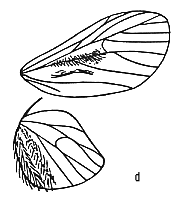|
�Eilema� fasciculosa Walker
Lithosia fasciculosa
Walker,
1862, J. Linn. Soc. (Zool.), 6:105.
Nishada testacea Rothschild, 1912, Novit. zool., 19:
217.
Diagnosis
and taxonomic note. The
shape and colour of the wings of this species are similar to those of typical Nishada
such as nodicornis, though lacking the brown apical mark of the forewing
underside. The costal zone of the male hindwing is separated off by a ridge of
scales that interacts with patches of thicker scaling on the underside of the
forewing, and the dorsum also is thickly scaled, pale dull orange (Fig 2d). The
venation of both wings is atypical of Nishada,
and more typical of Eilema sensu lato,
with the radial sector triple branch with the terminal bifurcation anterior
rather than posterior, and the angles of the hindwing cell each giving rise to
bifurcate systems (single veins in Nishada).
The male antennae are ciliate but lack such extensive dense scaling as seen
in typical Nishada. The male abdomen
lacks structures on the third tergite, and the valves are more entire, though
cleft ventrally to make the apical portion into a kind of cucullus. The aedeagus
vesica has two serrate, semicircular structures. The female has a thickened,
irregularly corrugated, pyriform corpus bursae, with two small scobinate signa
in the less heavily thickened distal part. E. griseoflava Rothschild is a closely related species from the
Philippines. The placement of both taxa needs further study.

Fig 2d: Eilema
fasciculosa Walker
Geographical
range. Borneo,
Peninsular Malaysia, Bali.
Habitat
preference. This
is a lowland forest species, though not recorded from heath forest and found
particularly commonly in alluvial forest during the Mulu survey.
<<Back
>>Forward <<Return
to Contents page
|

